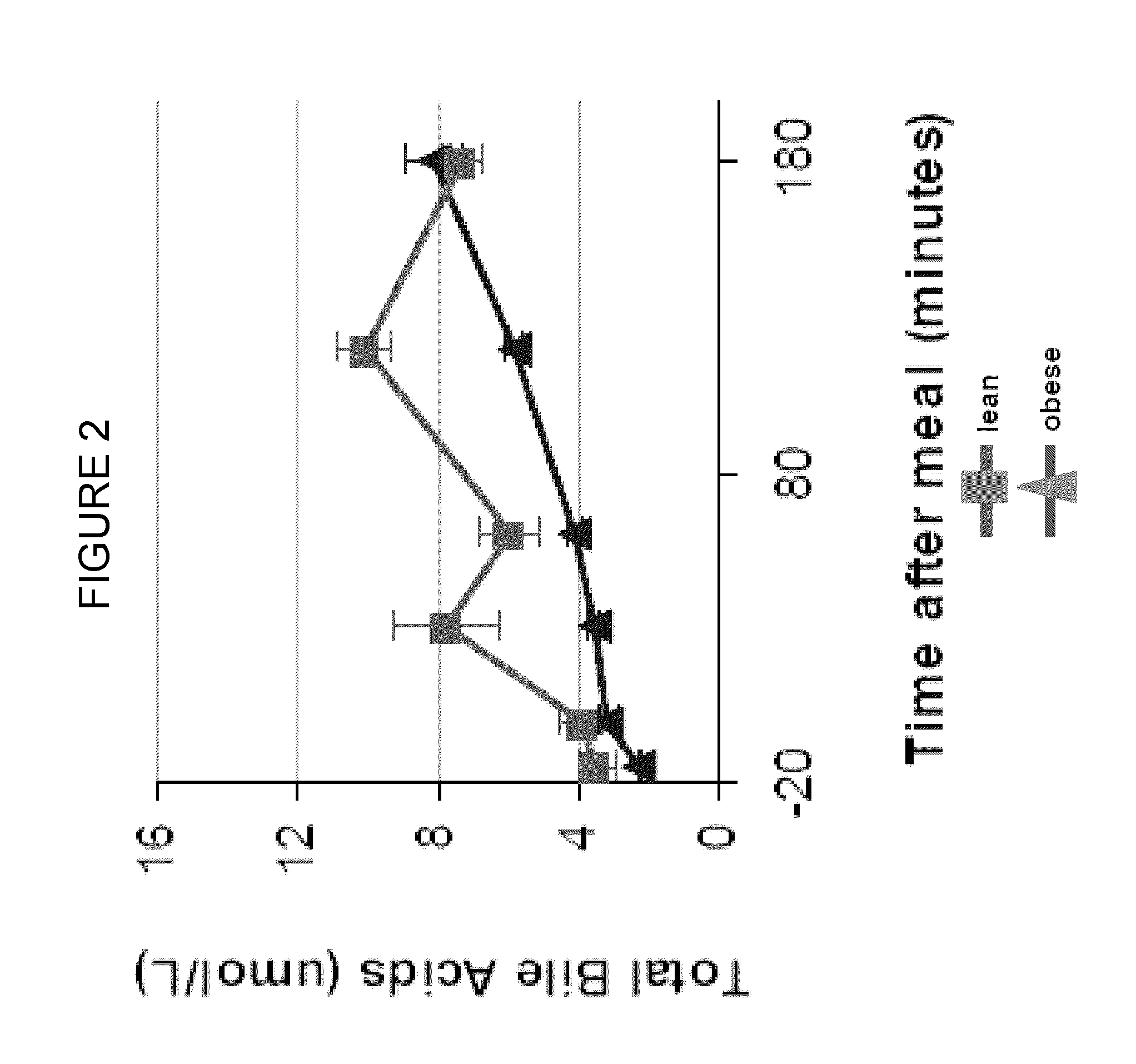Methods and compositions of bile acids
a bile acid and composition technology, applied in the field of metabolic disease treatment methods and compositions, can solve the problems of increasing the risk of premature death, increasing and requiring long recovery periods for patients, so as to increase bile acid levels, increase or decrease serum bile acid levels, and reduce the risk of severe health problems
- Summary
- Abstract
- Description
- Claims
- Application Information
AI Technical Summary
Benefits of technology
Problems solved by technology
Method used
Image
Examples
example 1
Bile Acid Measurements
[0164]Plasma sampling was performed on 16 obese human subjects and 8 gender- and age-matched normal weight controls. Table 1 shows the assessment of food intake for 4 days and assessment of physical activity for 3 days that was measured for each individual to establish a baseline of intake and energy expenditure.
TABLE 1Subjects' Activity MeasurementsMENWOMENOBESELEANOBESELEANN10464AGE* (Years)43.536.545.745.5BMI (kg / m2)44.222.638.720.8Activity* (kcal / kg)43.546.937.145.0Intake (kcal)2255277518621926*p > 0.05
[0165]In the limited cohort tested, the post-prandial bile acid responses appeared to be gender dependent. Post-prandial bile acid levels measured in lean men demonstrated well defined peaks and cycling of increases and decreases of bile acid levels. See FIG. 2. In contrast, obese men demonstrated blunted post-prandial bile acid levels with delayed increases and decreased cycling of bile acid levels. Bile acid conjugation also was decreased in obese men after...
example 2
Surgical Intervention and Bile Acid Levels
[0167]To determine whether Roux-en-Y gastric bypass (RYGB) induces changes in the circulating concentrations of bile acids, total serum bile acids were determined in obese subjects. Five subjects were given a liquid meal after an overnight 8 hour fast. The meal was taken slowly over 20 minutes and consisted of 8 oz, approximately 450 calories, 40% carbohydrate, 40% fat, and 20% protein. Serum bile acid measurements were taken 15 minutes prior to meal ingestion, at the end of meal ingestion (time 0), and 15, 30, 60, 90, 120, 150 and 180 minutes after ingestion. Measurements were repeated prior to RYGB procedure, 4 weeks post procedure and 40 weeks post procedure. FIGS. 7A-7E show that total serum bile acid levels were abnormal in obese individuals prior to surgery and surgery normalizes the bile acid response to food ingestion.
[0168]To determine whether individuals that have undergone surgical intervention demonstrate variances in bile acid l...
example 3
Individual Bile Acid Measurements
[0171]Circulating concentrations of individual bile acids were measured in lean and obese individuals. More than a dozen types of bile acids are known, such as cholic acid, chenodeoxycholic acid, deoxycholic acid, lithocholic acid, and ursodeoxycholic acid, as well as their taurine or glycine conjugated forms.
[0172]Levels of cholic acid (CA, FIG. 15), glycocholic acid (GCA, FIG. 16), taurine cholic acid (TCA, FIG. 17), chenodeoxycholic acid (CDCA, FIG. 18), glycine chenodeoxycholic acid (GCDC, FIG. 19), taurine chenodeoxycholic acid (TCDC, FIG. 20), deoxycholic acid (DCA, FIG. 21), lithocholic acid (LCA, FIG. 22), ursodeoxycholic acid (UDCA, FIG. 23), glycine deoxycholic acid (GDC, FIG. 24), glycine lithocholic acid (GLC, FIG. 25), taurine deoxycholic acid (TDC, FIG. 26), taurine lithocholic acid (TLC, FIG. 27), taurine ursodeoxycholic acid (TUDC, FIG. 28) were measured in subjects prior to surgical intervention and at 1 week post surgical interventi...
PUM
 Login to View More
Login to View More Abstract
Description
Claims
Application Information
 Login to View More
Login to View More - R&D
- Intellectual Property
- Life Sciences
- Materials
- Tech Scout
- Unparalleled Data Quality
- Higher Quality Content
- 60% Fewer Hallucinations
Browse by: Latest US Patents, China's latest patents, Technical Efficacy Thesaurus, Application Domain, Technology Topic, Popular Technical Reports.
© 2025 PatSnap. All rights reserved.Legal|Privacy policy|Modern Slavery Act Transparency Statement|Sitemap|About US| Contact US: help@patsnap.com



